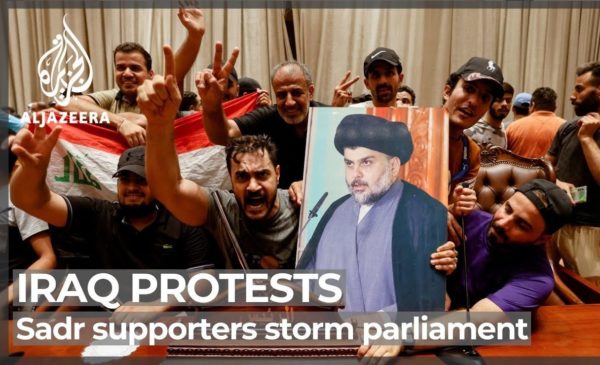By Maher Nazih
BAGHDAD- Thousands of supporters of Shi’ite populist cleric Moqtada al-Sadr stormed Baghdad’s fortified government zone on Saturday for the second time in a week, escalating a political stand-off that is hitting ordinary Iraqis hardest.
Protesters rallied by Sadr and his social-political Sadrist Movement tore down concrete barriers and entered the Green Zone, which houses government buildings and foreign missions, heading for Iraq’s parliament, a Reuters witness said.
The scenes followed similar protests on Wednesday, although this time several protesters and police officers were hurt as Sadr’s supporters threw stones and police fired teargas and stun grenades, according to security officials and medics.
Sadr’s party came first in a general election in October but he withdrew his lawmakers from parliament when he failed to form a government which excluded his Shi’ite rivals, mostly groups backed by Iran.
Sadr has since made good on threats to stir up popular unrest if parliament tries to approve a government he does not like, saying it must be free of foreign influence and the corruption that has plagued Iraq for decades.
The Sadrists chanted against Sadr’s Iranian backed political rivals who are now trying to form a government. Iraq has been without a president and prime minister for a record period because of the deadlock.
Sadr maintains large state power himself because his movement remains involved in running the country – his loyalists sit in powerful positions throughout Iraqi ministries and state bodies.
Iraqis linked neither to Sadr nor to his opponents say they are caught in the middle of the political gridlock.
While Baghdad earns record income from its vast oil wealth, the country has no budget, regular power and water cuts, poor education and healthcare, and insufficient job opportunities for the young.
Sadr opposes Iran’s grip on Iraq
In October 2021, Iraq held early elections for its 329-seat parliament. For more than eight months, the nation of 40 million people has remained in leadership chaos with a stalemate over the formation of a new government and a ruling coalition in parliament.
These early elections were demanded by millions of almost exclusively Shia Muslim demonstrators who protested the corruption of their own Shia-controlled government and Iran’s clout in Baghdad.
The demonstrations were partially successful. They catapulted Mustafa al-Kadhimi to the premiership, and he introduced a new electoral law that paved the way for the October vote. Inexplicably, many of the same demonstrators boycotted the elections that they had demanded, leading to a record low 42 percent voter turnout. Surprisingly, though, the results still inflicted a major blow against Iran’s supporters. The pro-Iranian militias, who murdered at least 600 demonstrators and wounded thousands of them, lost 26 out of their 48 parliamentary seats. Iranian allies remained strong but, like in the Lebanese elections of May 2022, the pro-Iranian parties lost their parliamentary majority in Iraq.
The great winner was Muqtada al-Sadr. Out of 329 seats, his mostly Shia Alliance Towards Reform party won the largest number, 73 in all, potentially turning him into a kingmaker.
Sadr is an Iraq-first nationalist who opposes Iranian control just as he opposed America’s invasion. Tehran’s main problem with him is his intense hatred of Iran’s champion in Iraq, former Iraqi Prime Minister Nouri al-Maliki, whose State of Law party won a considerable 34 seats.
(Reuters) / News Agencies


Leave a Reply
You must be logged in to post a comment.